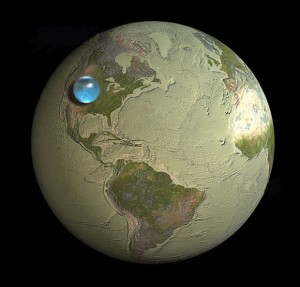NO SUBSTITUTE: Investing in the Future of Water
If you collected all of the water in the world, including oceans, lakes, glaciers, and even clouds, how much would that be? The resulting sphere would have a diameter of only 860 miles. Yet, this liquid skin still manages to cover 70% of our planet’s surface. Only a small fraction (less than 1%) of the world’s water is drinkable. It presents a major challenge for food security.
Many investors are beginning to think of water as an investable asset class – similar to oil or precious metals, but with less volatility.
Rising global demand makes investment in water conservation and supply a comparably safe bet for the future. Over the next three decades, the global demand for water is forecast to be 50% higher than today, according to a report by the Water Resources Group. This looks like an enormous amount, but it represents an increase of just 1.5% per year. Investments in water may create a steady stream of growth over the coming years, although they are also somewhat less likely to produce gushing profits.
Exchange-Traded Funds provide an easy way to invest in this theme. These provide a simple one-stop destination for investors who are looking for diversified exposure to the water industry. Here are a few ETFs worth considering:
- PowerShares Global Water Portfolio (ticker: PIO)
- Powershares Water Resources Portfolio (PHO)
- First Trust ISE Water Index Fund (FIW)
- Guggenheim S&P Global Water Index (CGW)
It is interesting to note that of these four choices, only the First Trust ISE Water Index has provided performance that exceeded the S&P 500 Total Return Index over the past 1, 3, and 5-year periods.
Getting Picky
In the next step, we take the holdings of these ETF funds, and filter them through a set of quantitative screens. We’ll see which water stocks “float to the top” in terms of relative value, safety, and momentum. For purposes of this analysis, we will only review stocks that are readily available on U.S. stock exchanges (including foreign ADRs).
Generally speaking, these companies fall into several different categories – Utilities, Infrastructure, and Consumer.
Utilities
In the U.S., close to 90% of the infrastructure for water is owned by local municipalities. As a result, there is a surprisingly tight universe of publicly-traded water utility companies.
Some of the more prominent names here include American States Water (AWR) andAmerican Water Works (AWK). These pay annual dividends of in the 3% range. Relative to the yields of other utility sectors, such as telecommunications or electric power, this is not all that exciting. The main draw here is a constant stream of income that comes with fairly low volatility.
Given the weaknesses in local government budgets, we may see increased privatization over the coming years. However, profit margins will likely be limited by regulation.
Infrastructure
According to the World Water Council, global infrastructure spending for water is around $80 billion per year and is forecast to double over the next few years.
Valmont Industries (VMI) sells mechanized irrigation systems in the U.S. and internationally. It is a “pipes and poles” company that also provides towers for the wind business and cell phone towers. Business has been growing steadily, with earnings per share up an average of 18% per year over the past five years.
Badger Meter (BMI) produces meters and measurement devices for water, gas, and commercial applications. The company’s data gathering and processing technology is an important step towards creating a smart-grid for utility systems. While the company’s share price has recently experienced strong upward momentum, it may be worthwhile to wait for less expensive entry point.
Danaher (DHR) is a conglomerate of sorts. Its environmental segment provides instrumentation and disinfection systems for drinking water. The company’s combination of growth and financial stability makes it an interesting selection.
Consumer
Helen of Troy (HELE) recently purchased the PUR home water filter business from Procter & Gamble. This consumer goods company is attempting to expand its home environment segment. It too, is attractively priced and has a conservative balance sheet.
Future Opportunities
So, if these companies represent the best of the present, what opportunities should we follow in the future? If we take look at the big picture over the next ten to twenty years, we may see three dominant trends emerge:
- The build-out of water infrastructure in the developing countries, particularly Africa and Southeast Asia. Population growth and increasing levels of prosperity will increase water demand on an absolute and per-capita basis.
- Population migration to areas where water supplies are abundant and predictable. Climate change and depleting aquifers create water distribution risks of “too much” and “too little.”
- The advancement of technology in water management.
70% of water usage is for agriculture, making this a prime area for innovation. Hydro-ponics and aeroponics are two agricultural technologies that use as little as one-percent of the water used in open-field farming. Capilix builds monitors for water quality as it is recycled through greenhouses and hydroponic farms.
Farmers are getting more sophisticated in their use of agricultural informatics. Dynamax is a pioneer in direct plant monitoring. Sap monitors and improved irrigation systems can reduce annual water demands by over 20,000 gallons per acre. Aquaspy uses wireless soil moisture sensors to accomplish similar goals.
On the infrastructure side of things, Bilexys is looking at “mining” the water waste stream for chemicals. Emefcy is building microbial fuel cells that convert wastewater into a source of renewable energy.
None of these companies are publicly-traded, but keep them on your “watch list.”
(December 8, 2012)

